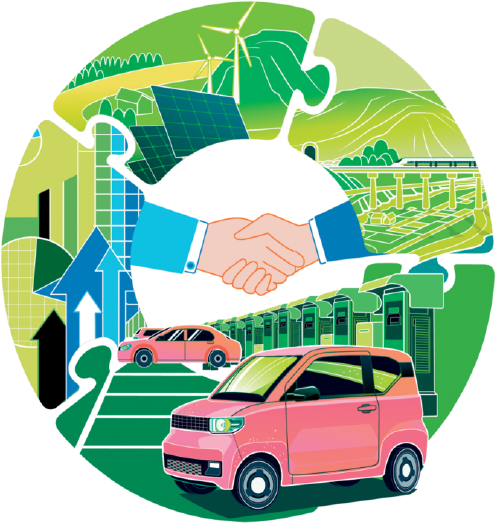近期,两场重要国际会议吸引了全球的关注:11月15日至16日,亚太经合组织(APEC)第三十一次领导人非正式会议在秘鲁首都利马举行,聚焦“赋能、包容、增长”;随后,11月18日至19日,二十国集团(G20)领导人峰会在巴西里约热内卢召开,主题为“构建公正的世界和可持续的星球”。在这些会议中,中国展现了其在推动绿色低碳发展和应对气候变化方面的积极角色,彰显了其作为负责任大国的形象。
在中国与拉丁美洲合作不断深化的背景下,中国与秘鲁、巴西在气候变化应对和碳市场治理等领域的双边合作也有望实现跨越式发展。正如中国—巴西应对气候变化联合声明中提出的“承诺拓展、深化和丰富气候领域双边合作、设立环境和气候变化分委会”等,进一步凸显了中国与两国在相关领域的合作潜力。
日前,ZIBS院长贲圣林和助理教授陆嘉骏在《中国日报》发表文章,深入分析了中国与秘鲁如何通过绿色技术转移和气候金融政策共同促进绿色发展。同时,陆嘉骏在《中国日报》发表了另外一篇文章,分析了中国和巴西在绿色低碳发展和气候变化应对方面的合作潜力。此外,陆嘉骏近期还在《浙商》杂志发文,深入探讨了中国当前一系列政策利好对资本市场情绪和投资前景的影响。以下为内容速览:
Partnership of promise
《中国日报》
China and Peru have great potential for collaborating on green technology and climate finance.
China has made remarkable strides in developing and deploying green technologies. In 2023, it became the world's largest investor in renewable energy, allocating over $100 billion annually to clean energy projects. The country leads in solar power production, wind energy capacity and electric vehicle manufacturing, accounting for more than 30 percent of global renewable energy capacity, according to the International Renewable Energy Agency. China's progress includes advancements in energy storage, carbon capture and storage, smart grid technologies, and EVs. These efforts have reduced China's carbon footprint and established a thriving green technology industry. China's carbon neutrality goal before 2060 aligns with the Paris Agreement, and highlights its potential as a global climate leader.

Peru is committed to carbon neutrality by 2050 and plays a critical role in preserving the Amazon rainforest, essential for global biodiversity and climate regulation. However, it faces challenges such as deforestation, air pollution and limited energy access in rural areas. Despite these obstacles, progress has been made, about 60 percent of Peru's electricity came from renewable sources in 2023, mostly hydroelectric power. However, Peru enjoys vast untapped potential in solar and wind energy. China's expertise in clean energy technologies offers sustainable solutions to these challenges and can help accelerate Peru's energy transition.
……
本文为陆嘉骏与ZIBS院长贲圣林共同撰写。以上为内容节选,阅读全文敬请访问:
https://www.chinadaily.com.cn/a/202412/03/WS674e63e9a310f1265a1d0bf1.html
Driving decarbonization forward
《中国日报》
The 2024 G20 summit in Brazil marks a critical juncture for global efforts to combat climate change. As the largest developing economies in Asia and South America, respectively, China and Brazil are uniquely positioned to lead the global decarbonization drive. Their shared commitment to sustainable development, coupled with complementary strengths, provides a strong foundation for cooperation.

China and Brazil have long acknowledged the urgent need for climate action. Both countries are signatories to the Paris Agreement and have submitted ambitious Nationally Determined Contributions aimed at reducing greenhouse gas emissions. China has pledged to peak carbon emissions before 2030 and achieve carbon neutrality by 2060. In 2023, China became the global leader in renewable energy investment, allocating over $100 billion annually to expand its wind, solar and hydropower capacities. The International Renewable Energy Agency reports that China now accounts for more than 30 percent of the world's installed renewable energy capacity, a remarkable achievement that underscores its global leadership in the sector. Meanwhile, Brazil, home to the world's largest rainforest and with significant renewable energy potential, is equally committed to decarbonization. The Amazon rainforest acts as a crucial carbon sink, absorbing millions of tons of carbon dioxide annually. However, illegal deforestation, primarily driven by agriculture and logging, threatens this critical resource. Brazil's NDCs include halting illegal deforestation by 2030 and increasing the share of renewables in its energy matrix, which already accounts for 83 percent of its electricity generation. Despite their unique challenges, China and Brazil share a mutual interest in advancing global decarbonization. Their collaboration offers a compelling model of South-South partnership, combining China's technological prowess and financial capacity with Brazil's natural resource endowments and biodiversity expertise.
……
以上为内容节选,阅读全文敬请访问:
https://www.chinadaily.com.cn/a/202411/25/WS6743c96ca310f1265a1cf4e6.html
一揽子增量政策蕴藏哪些机遇
《浙商》杂志
当前,在一系列重磅利好政策的刺激下,中国市场的资金做多情绪持续高涨。从国庆节前到现在,各类政 策的出台为市场注入了强大信心,导致各大机构对A股后市的展望愈发乐观,外资对中国资产的态度也发生了显著逆转。其中,央行货币政策等增量政策的推动作用显得尤为重要。
为刺激市场流动性,央行此次采取了一系列综合性措施,主要包括三项——
其一,降低存量房贷利率。
其二,降低存款准备金率。
其三,创设证券、基金、保险公司互换便利,自10月10日起接受申报。
10月18日,国家统计局公布2024年第三季度经济数据,前三季度GDP同比增长4.8%,10月份制造业采购经理指数(PMI)为50.1%,显示经济活动较弱,通缩压力依旧存在。在此背景下,决策层已推出一揽子增量政策以应对新挑战。研究团队通过分析现有经济运行规律,总结出以下可能的经济增长点:投资领域的“两重”建设,尤其是新型城镇化及城市更新;消费领域的“两新”工作,尤其是电动自行车更新及新能源汽车下乡;推进低空经济、智能制造等新质生产力的培育壮大;工信部加快推动专精特新企业发展和中小企业的数字化转型;支持民营企业参与国家重大战略和重大工程,包括在新兴产业和基础设施建设中的投资。这些旨在激活经济增长的利好政策,都是值得把握的重大机遇。
……
以上为内容节选,敬请关注《浙商》杂志了解更多。





